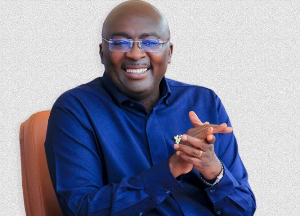- Home - News
- TWI News | TV
- Polls
- Year In Review
- News Archive
- Crime & Punishment
- Politics
- Regional
- Editorial
- Health
- Ghanaians Abroad
- Tabloid
- Africa
- Religion
- Election 2020
- Coronavirus
- News Videos | TV
- Photo Archives
- News Headlines
- Press Release
Business News of Wednesday, 7 August 2002
Source: Miningweb (Johannesburg)
Ashanti catching eye of investors
Ashanti Gold finally appears to be catching the eye of investors scouting for value and opportunity in the presently bullish price environment.
The company looked in fine fettle at the presentation of its second quarter results today, even though there was a loss after exceptional items compared with the same period last year.
The most important development reported during the Ghanaian gold producer's conference call was the removal of Credit Suisse First Boston as a hedge counterparty. CSFB was a thorn in the side for Ashanti's avuncular chief financial officer, Srinivasan Venkatakrishnan, who has been busily nursing the company back from a its 1999 hedge-induced coma.
The Swiss-American bank, which went stone cold on the precious metals market after it quit the London Gold Fix last October, had been unwilling to forego its right to margin calls against Ashanti. Margin free trading has been critical to restoring investor confidence and providing financial flexibility for the embattled company.
By getting CSFB off its back, Ashanti has swept away the insecure interim margin-free agreements it had secured earlier this year and it now trades with a much simpler hedge book. The company's positions are being lightened and the book is more akin to the spot deferred programmes run by the majors.
The company confirmed that its apparent deficit in meeting ounces committed to delivery by year-end will be met through spot deferrals, while measures have been taken to insulate the company from damaging cash calls at key periods.
Also contributing to the more positive picture is the relative resilience of the hedge book which has showed a year-over-year deterioration of $77 million to negative $150 million. That is tame against the backdrop of a sharply improved gold price.
Ashanti is positively glowing after retiring, ahead of schedule, all of its existing revolving credit facility, as well as outstanding exchangeable notes originally due in March 2003. The notes were seen as a key cap on the stock price. The company has since secured a new $200 million five-year revolver on better terms.
Lower financing costs played a key role in boosting earnings before exceptional items, which rose by a third to $18.8 million over the same quarter a year ago.
The increase was also achieved in the face of a 7% decline in second quarter production. For the half-year, production is off 3% to 778,000 ounces, but the net margin on each ounce produced is up more than a quarter from $65 per ounce to $82. The second quarter margin improved to 86% from 80% in the March period.
Get rid of Lonmin
Investors are itching for corporate action after a three-year hiatus. Robert Nap of Millennium Partners expressed typical frustration, noting that Ashanti trades at a 40% discount to net asset value while its competitors all command reasonable premiums. It is priced at around 20-5 times forward earnings which is a crying shame against comparable producers and especially some of the juniors that are racking up tech-bubble like multiples.
The view is that the Ghanaian government's "golden share" is not what's holding Ashanti back, but the further consolidation of Lonmin's stake in the company.
Ashanti chief executive Sam Jonah reiterated what the market already knows - that Lonmin is intent on dealing Ashanti into the consolidation game. The market is still rife with rumours that Gold Fields [GFI] is eyeing Lonmin as a vehicle to achieve a London listing, obtain more platinum exposure to compliment is Arctic Platinum project and cement its position in the Ghanaian gold fields.
Treasury boss Mark Arnesen surmised that the banks, who had converted their warrants into equity, were probably selling down their positions which was weighing on the stock price.
Analyst price targets are certainly in the buy range, north of $5. The most recent upgrade came from the well respected gold team at Goldman Sachs which rated it "Market Outperform" since 3 July. Prior to that JP Morgan downgraded the stock in May to a "Long-Term Buy".










